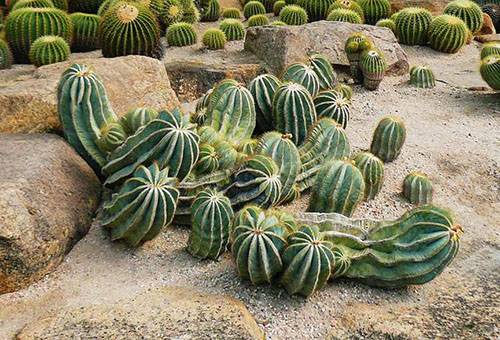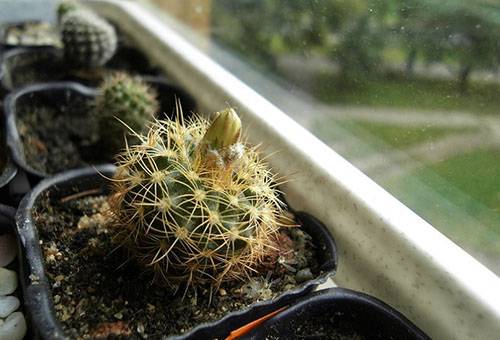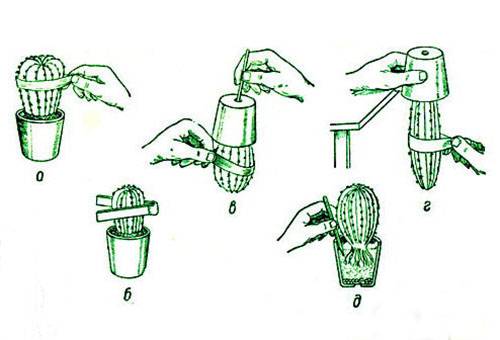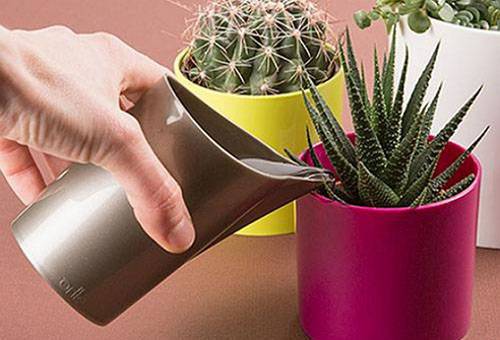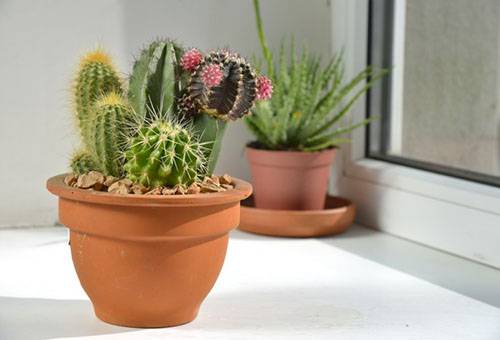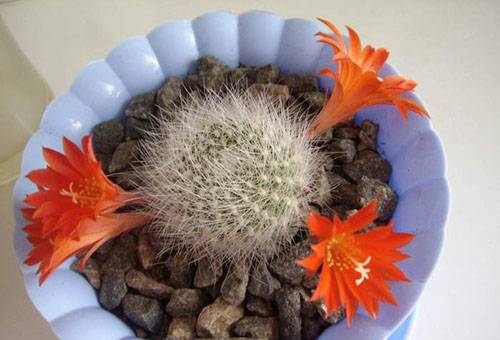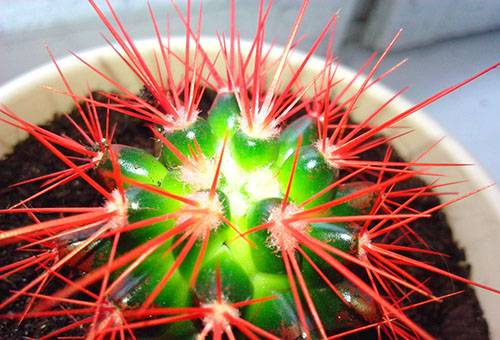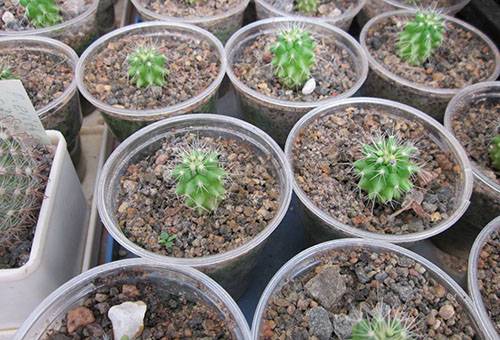Cacti on your windowsill and care for them at home
Content:
Half a century ago, a collection of cacti on the windowsill was a rarity, a sign of prestige and testified to the high status of its owner. Now this plant is widespread, and more and more people need the knowledge of proper cactus care at home.
Origin factor
When organizing the care of this exotic plant, two important rules should be kept in mind.
- All species of cacti are divided into two large groups according to their origin: from tropical moist forests (epiphytic) and from areas with a desert climate (cereus). This largely determines the mode of cultivation and care. Among the Cereus species are species of echinocactus, echinocerius, prickly pear. Forest epiphytic include zygocactus (Decembrist), epiphyllum, phyllocactus (the most common) and other leaf-like.
- It is necessary to take into account the biological characteristics of the growth of the species: slow growth and cyclicity - a change in the periods of rest and growth.
What land to plant?
Cacti need loose, breathable soil. Usually it uses sheet land and river sand in a 1: 1 ratio with small additions of peat and charcoal. At home, care for cacti is planted in small plastic or ceramic pots, only metal containers should be avoided, as rust can form in them.
Do not forget about the drainage device. Drainage is made up of small stones, broken shards, fragments of red brick, even plastic fragments can be put into action. However, if there is a hole in the pot, and the substrate is sufficiently permeable, then an additional layer of pebbles may not be required.
Need for transplants
When caring for a young plant, you need to renew the land often, at least once a year, and older cacti can be replanted in a few years. Transplants are carried out at the beginning of the vegetative period, that is, in the spring: from late March to early May. A few days before transplanting, watering is stopped so that dried soil can be easily separated from the roots.
Thorny stems and the trunk are wrapped with thick paper or plastic and carefully removed from the pot. Cut off sick, dried or rotten roots, sprinkling slices with crushed coal. The volume of the transplant pot should be proportionate to the volume of the root system.
Water according to the rules
Careful care of the cactus at home provides for differential watering of plants. In winter, at rest, watering is scarce: epiphytes watered once a week or even after 10 days. And people from the desert need watering no more than once a month. Some gardeners consider it possible not to water them at all until the beginning of spring. But these recommendations relate more likely to the courtship option, when the plant is cleaned for a period of rest in a shaded and cool place (5 - 15 degrees), which is not always possible at home.
Water for irrigation is used, as usual, settled, boiled or rain. It is important not to flood the stem at the base, otherwise whitish salt smudges may form on it.
In the summer, when flowers appear, watering is done more often, making sure that the substrate does not get wet or the water stagnates in the pan, because this can lead to decay of the roots. Watering time - morning or evening.
If you undertook to care for epiphytic cacti, natives of the tropics, then proceed from the fact that they are closer to just a humid climate. They need a warm soul, which must be arranged twice a month for 5 minutes.
Home climate: lighting and temperature
It is traditionally believed that cacti are photophilous. Indeed, inadequate lighting can cause disease, growth retardation and unevenness. At home, it is better to look after them on the south window, but some leaf-like cacti do not tolerate direct sunlight.
To increase the flow of fresh air - and this is one of the rules of care - many flower growers transfer their "pets" in the summer to balconies and even plant them in open ground. During hibernation, cacti are harmed by the dry air and the high temperature of home conditions. Florists place them between the frames; so that the root system does not get too cold, put the pots in a pan. Protect from drying out can be a barrier from the heating battery, made of transparent plastic.
Flowering - a sign of plant well-being
Cactus flowering is a small holiday that will take place due to proper care of the plant at home. A number of circumstances contribute to this.
- The sustained temperature and light conditions during winter rest.
- Regular watering and top dressing from the beginning of the period of vegetative growth.
- Maximum light and fresh air during flowering.
- The use of special fertilizers. The dosage of liquid humic fertilizer depends on the type of cactus: forest (epiphytic) are fed at the rate of 2 caps per 1 liter of water. And desert ones - 1 cap per 2 liters. Watered every 2 weeks.
If the cactus bloomed in the middle of winter, you do not need to feed it.
Tip
At the time of flowering, you must carefully care for the cactus. He can react negatively to a change in his location. Do not turn the pot with the plant out of motivation to improve lighting. You run the risk of getting the opposite result - flowers and buds may fall.
What is the best way to fertilize cacti?
You should be very careful about feeding cacti with mineral fertilizers, conduct several test dressings before finally deciding on a particular mixture. It is known that plants do not need additional nitrogen, which causes unhealthy growth and the appearance of “children” unsuitable for reproduction.
Agronomically grounded care for cacti prescribes fertilizers containing balanced phosphorus and calcium, at the time of flowering - potassium. Specially developed organic humic fertilizers for cacti, enriched with necessary microelements, will support normal plant growth at home, extend the flowering time. Only phosphorus does not combine with this fertilizer.
Breeding species
At first glance, nature has already taken care of the reproduction of a cactus that builds up children near the main trunk, and you don’t have to take special care of it. It remains only to carefully detach them and plant them in a separate bowl, since the root buds have already been formed and growth will begin in one to two weeks. (By the way, neither children nor cut cuttings are ever put into water). But not all types of cacti are able to reproduce in this way.
Let us leave aside the germination of a plant from seeds as labor-intensive and requiring special attention and preparation.
Branched and columnar cacti at home usually cuttings, at the same time getting rid of damaged and diseased sections of the trunk or shoot. To cut the cuttings, they find an excessively long, overgrown or corked trunk and cut it off using a sharp, best clerical, razor-bladed knife, previously sterilized.
A fresh section of the trunk is slightly dried in the sun and sprinkled with finely chopped charcoal, and the stalk is sent to a dry room for 7-10 days.When the cut is tightened with a glassy layer, it is time to plant it in a prepared substrate, covered with a layer of coarse river sand, 1 cm deep. For greater stability, the stalks are tied up and then covered with a glass jar. They start watering when the plant takes root, and until that time you can only moisten the sand.
We recommend reading the article: Aglaonema care
